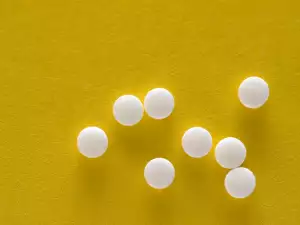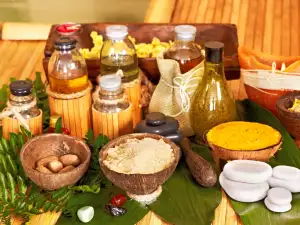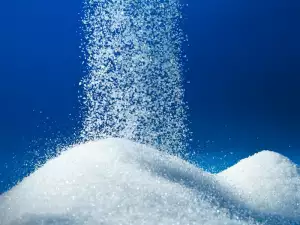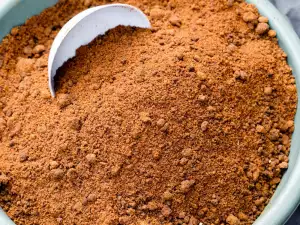Cyclamate (E952) (Synonyms: sodium N-cyclohexylsulfamate) is a food additive and a synthetic sugar substitute. It mimics the effects of sugar taste like other sweeteners, with the difference that it contains less energy, ultimately 0 kcal. Cyclamate belongs to the group of so-called high sweeteners - substances that are tens or hundreds of times sweeter than regular sugar, which group includes aspartame (E951), acesulfame K (E950), Sucralose (E955), saccharin (E954), neotame and others.
Cyclamate was synthesized in 1937 and later widely used as a low-calorie sugar substitute, it is mentioned as a good alternative for diabetics. Cyclamate is 30-50 times sweeter than sucrose in a concentration-dependent way (non-linear dependence) and is usually a frequent component of the complex texture of sugar substitutes in tablets.
There are two types of E952 - sodium cyclamate and calcium cyclamate + cyclamic acid. The most commonly used one is sodium cyclamate. All of them, unlike saccharin, lack a metallic taste. Their only advantage over saccharin is that Cyclamate no residual metallic taste that remains in the mouth after consumption of saccharin.
In general, they are added to food to enhance the flavor. Sweetening textures that are different from sugar added to food or drink to maintain a low nutritional value, in other words, no calories. The official version is that synthetic sweeteners such as cyclamate, saccharin and aspartame are good for diabetics, but it is becoming increasingly controversial.
Currently Cyclamate is 30 to 50 times more sweet than sucrose and is the weakest of the many artificial sweeteners. Studies found that it can cause cancer. In the 50s of last century, diet drinks included a mass composition mixture of saccharin and cyclamate.

In 1969, however, laboratory tests were conducted on mice with chronic toxicity, which shows that this mixture causes cancer in laboratory rats. Experts rushed to explain that rats are generally prone to cancers and their life was shorter than that of humans.
Anyway, in 1970 Cyclamate was banned for use in foods, beverages and medicines in the U.S. Within the old continent, Cyclamate is banned in the UK but is permitted in many other European countries, including Bulgaria. Today, more than 55 countries still approve the use of cyclamate.
Safe daily dose
Cyclamate is allowed in concentrations up to 2500 mg / kg, and Saccharin - at concentrations 3000 mg / kg. A safe dose for a human is no more than 0.8 grams per day. The chemical formula of cyclamate is C6H13NO3S.Na
Where you can find cyclamate
Cyclamate , like most sweeteners, is widely used as an inexpensive raw material for the food industry. You can find it in almost every item on the label that says "0 calories". As already mentioned, Cyclamate is resistant to heat treatment and widely used in food preparation that requires similar treatments. It is an integral part of most marketed sweeteners.
Cyclamate can be found in cheap candy, waffles, non-alcoholic drinks, shakes, energy and sports drinks, dairy products, marmalades and jams, chocolates, hot teas, cereals, all kinds of pastries and baked goods, puddings and jellies and even lot of cosmetic products.
Benefits of cyclamate
For one reason or another, cyclamate is used today in some places, and is incorporated in all kinds of products.
A big plus with the use of cyclamate is the strength and protection of teeth and lack of residual metallic flavor, which comes with the use of saccharin. For some, a big plus is the lack of calories and that cyclamate dissolves easily in water and withstands very high temperatures. This makes cyclamate suitable for culinary use, because food can be sweetened in the process of preparing.

Dangers of cyclamate
It is reasonable to ask how a sweetener may be banned in some countries, in others its use is permitted (mainly in Eastern Europe). Cyclamate damage is constant everywhere and in it lies latent danger of developing dreadful diseases over time. Because the effects of sweeteners are not instantaneous, they accumulate in the body until a disease appears.
The truth is that food producers and moguls are not particularly interested in the personal health of each person. The emphasis is that Cyclamate is cheap and very suitable for use in all kinds of food, because it can withstand high temperatures.
After the end of the 60s, it was shown that cyclamate is quite likely to cause cancer in laboratory mice, recent studies brought to light that the sweetener is absolutely counter- indicated for people suffering from kidney failure. The sweetener is obtained by extraction from cyclohexylamine and sulfamic acid and this substance is metabolized to a limited extent by the bacteria in the intestines. For some of us, there is reduced absorption from the gut, but the substance is released unchanged by the kidney.
Cyclamate , like other synthetic sweeteners, is unsuitable for use and during pregnancy and lactation.
Added to the stomach by the action of bacteria living there Cyclamate becomes a a substance that has not been investigated and studied much, which is probably why this sugar substitute is banned in the U.S. and some EU countries.














Comments